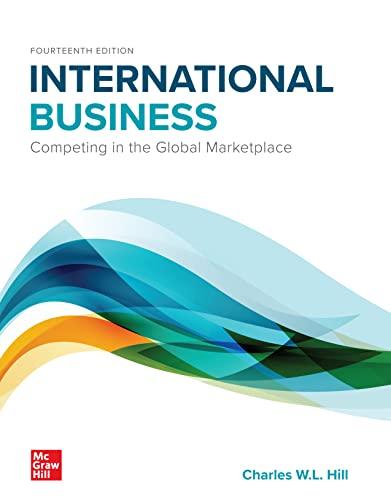Established in 1891 in Holland, Philips is one of the worlds oldest multinationals. The company began making
Question:
Established in 1891 in Holland, Philips is one of the world’s oldest multinationals. The company began making lighting products and over time diversified into a range of businesses that included domestic appliances, consumer electronics, and health care products. From the beginning, Holland’s small domestic market created pressures for Philips to look to foreign markets for growth. By the start of World War II, Philips already had a global presence. During the war, Holland was occupied by Germany. By necessity, the company’s national organizations in countries such as Britain, Australia, Brazil, Canada, and the United States gained considerable autonomy during this period.
After the war, a structure based on strong national organizations remained in place. Each national organization was, in essence, a self-contained entity that was responsible for much of its own manufacturing, marketing, and sales. Most R&D activities, however, were centralized at Philips’ headquarters in Eindhoven, Holland.
Reflecting this, several product divisions were created.
Based in Eindhoven, the product divisions developed technologies and products, which were then made and sold by the different national organizations. During this period, the career track of most senior managers at Philips involved significant postings in various national organizations around the world.
For several decades, this organizational arrangement worked well. It allowed Philips to customize its product offerings, sales, and marketing efforts to the conditions that existed in different national markets. By the 1970s, however, flaws were appearing in the approach. The structure involved significant duplication of activities around the world, particularly in manufacturing, which created an intrinsically high-cost structure. When trade barriers were high, this did not matter so much, but by the 1970s, trade barriers were starting to fall, and competitors, including Sony and Matsushita from Japan, General Electric from the United States, and Samsung from Korea, were gaining market share by serving increasingly global markets from centralized production facilities where they could achieve greater scale economies and hence lower costs.
Philips’ response was to try to tilt the balance of power in its structure away from national organizations and toward the product divisions. International production centers were established under the direction of the product divisions. The national organizations, however, remained responsible for local marketing and sales, and they often maintained control over some local production facilities. One problem Philips faced in trying to change its structure at this time was that most senior managers had come up through the national organizations.
Consequently, they were loyal to them and tended to protect their autonomy.
Despite several reorganization efforts, the national organizations remained a strong influence at Philips until the 1990s. In the mid-1990s, Cor Boonstra became CEO. He famously described the company’s organization structure as a “plate of spaghetti” and asked how Philips could compete with 350 companies around the world and significant duplication of manufacturing and marketing efforts across nations. Boonstra instituted a radical reorganization. He replaced the company’s 21 product divisions with just seven global business divisions, making them responsible for global product development, production, and marketing. The heads of the divisions reported directly to him, while the national organizations reported to the divisions. The national organizations remained responsible for local sales and local marketing efforts, but after this reorganization, they finally lost their historic sway on the company.
Philips, however, continued to underperform its global rivals. By 2008, Gerard Kleisterless, who succeeded Boonstra as CEO in 2001, decided Philips was still not sufficiently focused on global markets. He reorganized yet again, this time around just three global divisions:
health care, lighting, and consumer lifestyle (which included the company’s electronics businesses). The divisions were responsible for product strategy, global marketing, and shifting production to low-cost locations (or outsourcing production). The divisions also took over some sales responsibilities, particularly dealing with global retail chains such as Walmart, Tesco, and Carrefour. To accommodate national differences, however, some sales and marketing activities remained located at the national organizations.
In the second decade of the twenty-first century, Philips continued to evolve. It sold many of its electronics businesses, and in 2016, it divested its original lighting business. The remaining activities of the company were now much more focused on the global health care area, which has proved to be a fast-growing and profitable business for Philips. It continues to operate with global product divisions, with national and regional subsidiaries reporting to the product divisions, and is primarily responsible for local sales, marketing, regulatory approval of medical equipment, and in some cases, product development.
Case Discussion Questions 1. Why did Philips’ organization structure make sense in the 1950s and 1970s? Why did this structure start to create problems for the company in the 1980s?
2. What was Philips trying to achieve by tilting the balance of power in its structure away from national organizations and toward the product divisions? Why was this hard to achieve?
3. What was the point of the organizational changes made by Cor Boonstra? What was he trying to achieve?
4. In 2008, Philips reorganized yet again. Why do you think they did this? What were they trying to achieve?
Step by Step Answer:

International Business Competing In The Global Marketplace
ISBN: 9781260387544
14th Edition
Authors: Charles Hill





